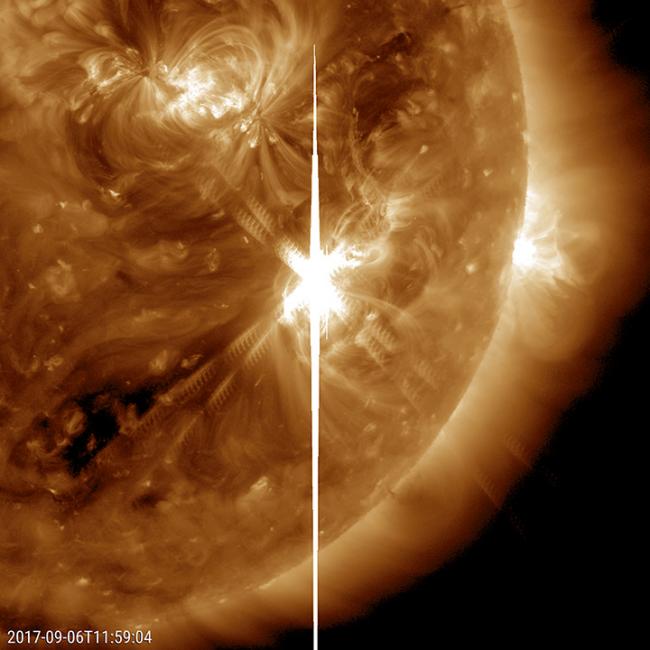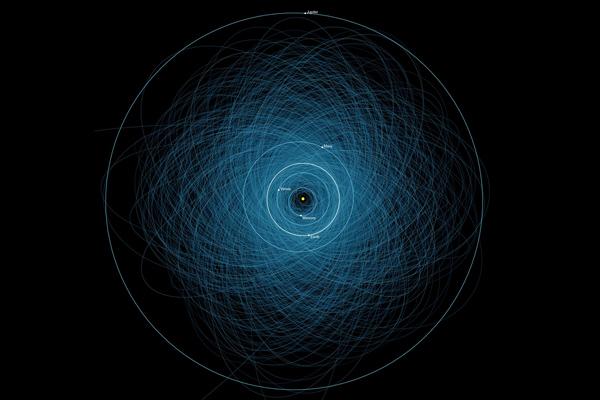How can astronomy improve life on earth?
Much of astronomy is concerned with understanding distant phenomena, seeing the invisible, and studying the most extreme events in the Universe. But how does this pursuit help our daily lives here on Earth?
Our Work
The need for extremely precise instrumentation in astronomy can often be transferred into the medical field. Beyond pure research, which benefits humanity through various technological applications, some laboratories at the Center for Astrophysics pursue research that’s more directly beneficial.
High-energy and neutron optics laboratories design mirrors for the next generation of space-based telescopes. But with a simple modification, these optics can accurately aim high-energy particles for radiation treatment, focusing on destroying tumors while leaving surrounding tissue unharmed. Engineers are working on mirrors that can both focus neutrons from across the Universe, as well as those from a radioactive source sitting in the same room.
Work on nuclear magnetic resonance, which can be used to study molecular physics, can also be used to scan the human body. When used for imaging, this is known as magnetic resonance imaging, or MRI. Scientists at the CfA are developing an open-access, low-magnetic-field human MRI instrument, that can be used for molecular imaging and the study of traumatic brain injury.
On the other side of the coin, astrophysics sometimes adapts technology from the medical field. The complicated debris leftover after a supernova explosion, known as a supernova remnant, can be hard to visualize. We only have our vantage point and cannot travel around the remnant to view the intricacies of its structure. But by measuring how fast the material is traveling, and whether it’s traveling towards us or away, we can create a 3D map of the material’s motion. Supernova researchers are putting this data into medical imaging software originally designed for brain scans to get a 3D model that can be viewed in 360 degrees. To take it one step further, the models can then be 3D printed, allowing you to hold a dead star in your hand.
The Center for Astrophysics | Harvard & Smithsonian sets the standard for astronomical discovery. By pursuing scientific research, our scientists never know what might be the next big breakthrough. New detector technology means better lighter cameras. Astronomical data analysis software can be reconfigured to make cars safer. Novel techniques in radio astronomy paved the way for wireless internet. We don’t know what we are going to find, but we will never know if we don’t look.
How Curiosity Drives Ingenuity
Understanding our Universe is not an easy task. It requires an incredible amount of focused effort among worldwide collaborations of dedicated experts, the constant development of new technology at great expense, and theoretical modelling that pushes the boundaries of science. Even without any guarantee of success, such an undertaking has its benefits.
Astronomy is continually innovating and progressing. Seemingly by accident, scientific and technological developments in astronomy have worked their way into our daily lives. For example, the device you’re currently reading this text on is very likely to involve components and systems that saw their first application in astronomy.
Computers, satellites and the smartphones they service, Global Positioning System (GPS), energy-efficient solar panels, digital camera sensors, airport security scanners, portable X-ray machines, and Magnetic Resonance Imaging (MRI) scanners are just a few of technological advances that are the legacy of astronomy, and that benefit us all on Earth. None of these would have happened if we hadn’t first been dedicated to simple human curiosity about what may be out in the far reaches of our Universe. As it has been throughout our history, the impulse to explore is still one of the greatest wellsprings of human ingenuity.
Protecting the Planet
In 1859, the Sun launched an enormous magnetized mass of plasma at the Earth, shorting electrical lines, starting electrical fires and knocking out telegraph communication. The northern lights could be seen as far south as Mexico. If such a solar event hit the Earth today, it is estimated to cause damage measured in the trillions of dollars.
Coronal mass ejections (CMEs), like the 1859 event, are giant eruptions of charged particles that threaten satellites, astronauts, and our electrical grid. A suite of CFA missions and instruments are monitoring the Sun, giving us warning of incoming CMEs, allowing time to prepare and protect people and our highly susceptible electronic and communication systems.
The X-ray Telescope (XRT) aboard the Hinode spacecraft observes flares, CMEs, and the source of the highly charged flow of particles from the Sun, known as the solar wind.
The Atmospheric Imaging Assembly (AIA), developed by scientists at the Center for Astrophysics | Harvard & Smithsonian (CfA), aboard the Solar Dynamics Observatory (SDO) takes fast, multi-wavelength images of the full sun. This allows scientists to watch monitor features at different temperatures and levels of the solar atmosphere.
The Parker Solar Probe, will race through the Sun’s atmosphere, collecting material and measuring the solar wind at its source. It will eventually orbit seven times closer than any previous satellite, and withstand temperatures of 2,500 degrees (1,377 degrees Celsius). The Solar Wind Electrons Alphas and Protons (SWEAP) Investigation, developed by CfA scientists and engineers, is the set of instruments on the spacecraft that will directly measure the properties of the plasma in the solar atmosphere during these encounters. A special component of SWEAP is a small instrument that will look around the protective heat shield of the spacecraft directly at the Sun. This will allow SWEAP to sweep up a sample of the atmosphere and touch the Sun, our star, for the first time.
Our Sun makes life on Earth possible, but is still an unpredictable, sometimes volatile star. By learning more about our Sun, astronomers can warn us about incoming solar storms and predict the next big eruption.

This image from NASA's Solar Dynamics Observatory shows a large sunspot that produced a coronal mass ejection in 2017. Astronomers monitor solar weather to help predict when such storms might hit Earth, affecting communications and power grids.
Space Watch
Though the Solar System has certainly cleaned up its act in the 66 million years since an asteroid wiped out the dinosaurs, there have since been a couple of near misses that are too close for comfort.
The Minor Planet Center, located at the Center for Astrophysics, is tasked by the International Astronomical Union to collect and circulate positional measurements of minor planets like asteroids and comets. The Center calculates the motions of newfound objects and alerts observers when an object that might impact the Earth is detected. The orbit calculation and announcement of newly discovered Near-Earth Asteroids (NEOs) is a critically important job, ensuring that we won’t suffer the same fate as the dinosaurs.

This diagram shows some of the orbits of known Near Earth Objects (NEOs), asteroids and other bodies that pass close to our planet. Tracking such objects helps us understand how likely they are to strike Earth; thankfully, no known NEO is currently a danger to us.
Benefits Beyond the Balance Sheet
Astronomy has a unique ability to unite humans. Simply by asking big questions about the Universe and our place in it, we see ourselves as we are: together, voyaging through a singular moment in time on one very special but relatively minuscule planet among the vastness of space.
The sense of wonder inspired by humanity’s quest for knowledge of our Universe has its own important applications. In education, we see the teaching of astronomy at the primary or secondary level leading students to pursue careers in STEM (science, technology, engineering, and math). In international relations, we see astronomy as a scientific field that transcends borders and promotes collaboration between global teams in unified pursuit of knowledge. In our culture, we see the impact of keystone scientific discoveries creating a more informed and scientifically literate society.
And let’s not forget that astronomy offers us a glimpse into our shared future. Will our species be able to spread across the cosmos, to colonize other planets, and to preserve our heritage and legacy through the ages? If so, it will only be through the study of astronomy.
Related News
Smithsonian Scientists Help Uncover How the Solar Wind Gets its Energy
Could Space Dust Help Protect the Earth from Climate Change?
Mars as a Base for Asteroid Exploration and Mining
Matthew Payne Named Director of the Minor Planet Center
Incoming Postdoc Awarded 51 Pegasi B Fellowship
To Navigate the Heavens, Take a Seat
Scientists Explain Mysterious Finger-like Features in Solar Flares
Remembering Astronomer Henrietta Swan Leavitt
Spacecraft Enters the Sun's Corona for the First Time in History
A Catalog of Solar Stream Interactions
Projects
AstroAI
HITRAN and HITEMP Database
Sensing the Dynamic Universe
SDU Website
Telescopes and Instruments
AIR-Spec/ASPIRE
Visit the AIR-Spec Website
Deep Space Climate Observatory (DSCOVR)
Visit the DSCOVR Website
High Resolution Coronal Imager (Hi-C)
Visit the Hi-C Website
Hinode
Visit the Hinode/XRT Website
Interface Region Imaging Spectrograph (IRIS)
Visit the IRIS Website
MicroObservatory Telescope Network
Visit the MicroObservatory Telescope Network Website
Parker Solar Probe
Visit the Parker Solar Probe SWEAP Website
Solar and Heliospheric Observer (SOHO)
Visit the SOHO/UVCS Website
Solar Dynamics Observatory (SDO)
Visit the SDO Website
TEMPO
The Coronal Spectrographic Imager in the EUV (COSIE)
Transition Region and Coronal Explorer (TRACE)
Wind Spacecraft
Visit the Wind Spacecraft Website